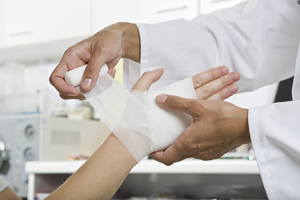Effective Burn Treatment in Tampa, FL

Burn injuries are common and can occur in a variety of ways. A skin burn can result from contact with a hot object, open flame, electrical current, harmful chemical, or steam. Sunburn can develop after exposure to ultraviolet (UV) rays from the sun, an indoor tanning device, or radiation therapy for medical treatment. A friction burn is a type of abrasion that can form if skin is scraped off through contact with a hard surface, such as a rope, carpet, or pavement. Frostbite is a burn that can result from exposure to extreme cold.
In addition to causing pain, any type of burn can break the skin—the body’s protective “coat of armor”—which increases the risk of infection. Because burns can vary widely in severity, it is important to be able to quickly judge the seriousness of the injury so you will know what to do. To help you decide when and where to seek burn care, the experienced team of medical providers at South Tampa Immediate Care in Tampa, Florida, offers the following information:
What Are the Different Types Of Burns, and How Do They Differ in Severity?
Burns are categorized into three main types based on their severity:
First-Degree Burns
The least severe type of burn, a first-degree burn affects only the outer layer of skin (epidermis). The injury may cause redness, tenderness, and/or mild swelling.
Second-Degree Burns
More serious than a first-degree burn, a second-degree burn causes damage that extends through the epidermis and into the middle layer of the skin (dermis). The affected skin may be hot, deep red, swollen, and/or blistered.
Third-Degree Burns
A third-degree burn is a life-threatening injury that affects all layers of skin underneath the burned area. The affected skin may look white, charred, or leathery. The damage may extend to the underlying hair follicles, sweat glands, fatty tissues, muscles, nerves, and/or bones. If the burn has damaged a nerve, numbness may develop.
What Immediate First Aid Measures Should Be Taken For a Burn Injury?
If your skin is burned, you should immediately:
- Get away from the heat source to prevent further injury
- Remove any clothing or jewelry near the burned skin to prevent constriction if swelling occurs
- Cool the burn by running cool water over the affected skin for 10 to 15 minutes or until the pain subsides (do not use cold water or ice, which can further damage the skin)
- Gently clean the burned skin with mild soap and cool water to help prevent infection (avoid breaking any blisters that may have formed)
- Cover the burn with a sterile, non-adhesive dressing or a clean cloth to protect it from infection
- Take an over-the-counter pain reliever, such as ibuprofen or acetaminophen, to reduce pain and inflammation if needed
When Is It Necessary to Seek Professional Medical Treatment for a Burn, and What Can Be Expected During Treatment?
Burns are dynamic injuries, which means the heat may linger and continue to penetrate and damage the skin and underlying tissues. If your burn is extremely painful or resulted from an inhalation injury or exposure to a chemical or electrical current, you should seek emergency medical attention at the nearest hospital ER.
Otherwise, you should seek professional medical attention if the burned area is larger than 3 inches in diameter or if the burn affects your face, hands, groin, or a large joint, such as your knee. If you are unsure about the severity of your burn, you should see a healthcare provider right away.
First-Degree Burn Treatment
Usually, home treatment is sufficient for a first-degree burn, which should heal within approximately one week. In the meantime, it may be helpful to take an over-the-counter pain reliever and apply cool compresses or aloe vera gel to the burned skin, which may peel or flake as it heals.
Second-Degree Burn Treatment
After evaluating the burn, a physician can suggest an appropriate treatment strategy. In addition to general home care, second-degree burn wound management may include a prescription medication and/or antibiotic ointment.
Third-Degree Burn Treatment
A third-degree burn is a severe injury that requires professional treatment, which may involve:
- Cleaning and debridement – Because a third-degree burn can damage all skin layers as well as the underlying tissues, a physician may need to clean the burn area and remove any dead tissue (eschar).
- Dressing and wound care – To help prevent infection, protect the injury, and promote proper healing, a physician may apply a topical medication, such as an antibiotic, and then cover the burn with a sterile dressing.
- Pain management – A physician may suggest a prescription-strength pain reliever to help manage the pain of a third-degree burn.
- Rehabilitation – Depending on the extent of the burn, a physician may suggest physical therapy to help restore function and mobility.
Some third-degree burns require surgical treatment. This may involve skin grafting, in which healthy skin is taken from another part of the body and used to cover the burned area. Surgery is usually followed by long-term follow-up care to monitor for complications, such as infection and scarring.
If you have questions about burn first aid or are searching for a reliable healthcare clinic in Tampa that can provide fast and effective treatment for minor burns, you can confidently entrust your care to South Tampa Immediate Care. After you arrive at our walk-in medical center, we will promptly assess your injury and provide appropriate burn care. If we determine that you need emergency treatment, we can refer you to a nearby hospital.












